

The waxing gibbous moon travels away from the star Spica and toward the dazzling planet Jupiter on the nights of April 28, 29 and 30, 2018.
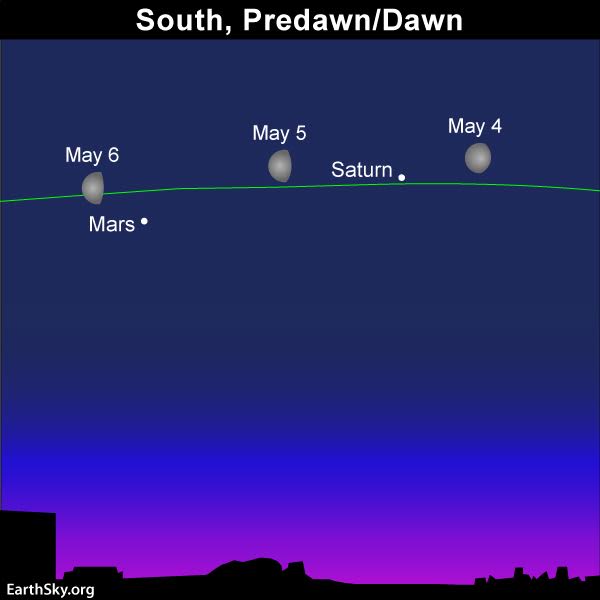
The moon couples up with Saturn in the morning sky on May 4 and Mars on May 6. Read more.
Follow the links below to learn more about the planets in May 2018:
Mars and Saturn, Jupiter, Venus, Mercury
Mars and Saturn rise into the southeast sky quite late at night throughout May (especially as viewed from the Northern Hemisphere). Your best view of them is in the predawn hours, when these planets appear much higher up in the sky. You can tell Mars from Saturn because Mars has a reddish color. Saturn looks golden. Binoculars show their colors better than the eye alone.
Mars and Saturn shine in front of Sagittarius, the constellation marking the direction to our galaxy’s center. Use the moon to locate Mars and Saturn on the mornings of May 4, 5 and 6. As the month progresses, Mars travels farther and farther east of Saturn on the sky’s dome, to move out of the constellation Sagittarius and into the constellation Capricornus by mid-May 2018. Saturn, in the meantime, stays in front of the constellation Sagittarius for a few more years.
At present, both Mars and Saturn shine as brilliantly as 1st-magnitude stars. However, Mars is brighter than Saturn. Saturn’s brilliance will increase until it peaks at its June 27 opposition, and Mars’ brilliance will also increase until it peaks at its July 27 opposition.
But Saturn’s brightness increase will be subtle, while Mars’ will be dramatic! It’s not often that Mars outshines Jupiter, normally the fourth-brightest celestial object to light up the sky. The three brightest celestial bodies are the sun, moon and Venus. But Mars will actually become the fourth-brightest for a couple of months in 2018, centered on Mars’ July 27 opposition. Remember Mars’ historically close opposition of August 28, 2003? That year, it was closer and brighter than it had been in some 60,000 years. This upcoming July opposition will be the best since then.
In early May, at mid-northern latitudes (U.S., Europe, Japan), Saturn rises about 11 p.m. local time (12 midnight local daylight-saving time) and Mars follows Saturn into the sky roughly an hour later. By the month’s end, Saturn comes up just after nightfall (about when Venus sets) whereas Mars doesn’t climb above the horizon until roughly 11 p.m. local time (12 midnight local daylight-saving time).
As for temperate latitudes in the Southern Hemisphere (South Africa, southern Australia, New Zealand), Saturn rises around 9 p.m. local time and Mars about an hour later, around 10 p.m. local time. By the end of the month, Saturn rises around 8 p.m (about when Venus sets) and Mars comes up about 10 p.m.local time.
Read more: Mars brighter in 2018 than since 2003
Click here for more about close and far Mars oppositions
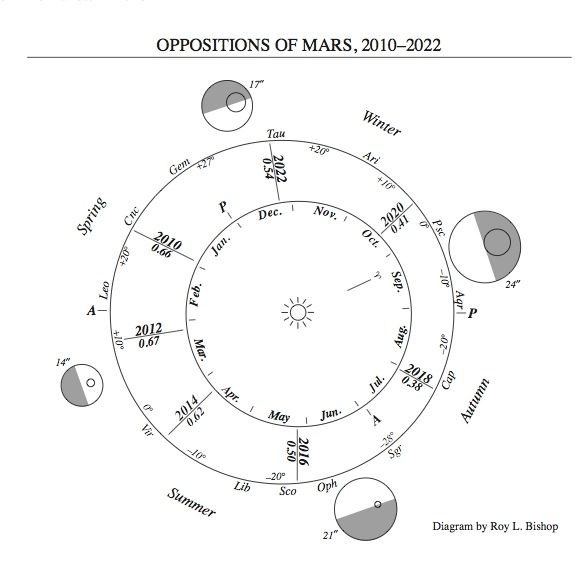
Diagram by Roy L. Bishop. Copyright Royal Astronomical Society of Canada. Used with permission. Visit the RASC estore to purchase the Observers Handbook, a necessary tool for all skywatchers. Read more about this image.
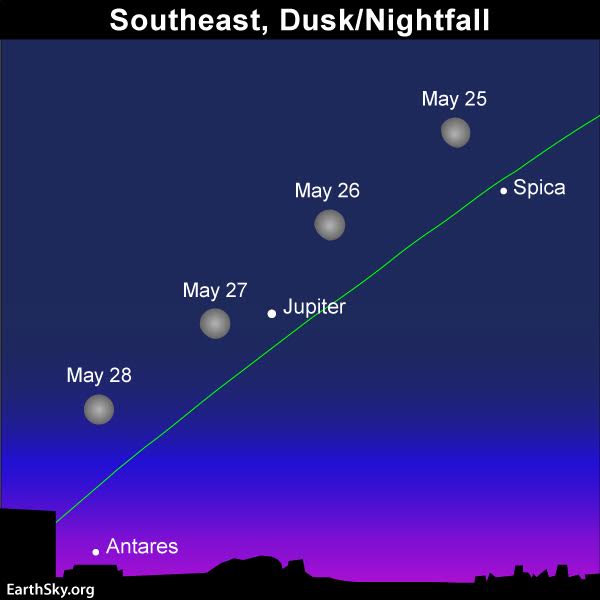
The green line depicts the ecliptic – the pathway of the sun, moon and planets in front of the constellations of the zodiac. Let the moon guide your eye to the stars Spica and Antares, and the planet Jupiter, on May 25, 26, 27 and 28. Read more.
Jupiter enjoys its moment of glory as it reaches opposition on the night of May 8-9, 2018. In May 2018, Jupiter ranks as the fourth-brightest sky object, after the sun, moon and Venus. Look southeast at nightfall or early evening, and if you see a starlike object near the horizon that’s brighter than any star, that’s probably Jupiter. Late in the month, let the moon guide your eye to Jupiter on the evenings of May 25,26, 27 and 28.
In early May, at mid-northern latitudes (U.S., Europe, Japan), Jupiter comes up at roughly 10 p.m. (11 p.m. daylight saving time) local time. At temperate latitudes in the Southern Hemisphere (South Africa, southern Australia and New Zealand), Jupiter is up around 9 p.m. local time in early April. After Jupiter rises, it’s out for the rest of the night.
Around its opposition on on the night of May 8-9, 2018 – when Earth flies between Jupiter and the sun, gaining a lap on the planet for this year – Jupiter will be rising in the east as the sun sets in the west, to beam all night, from dusk until dawn.
It’ll be fun to watch Jupiter and Venus in May. Early in the month, at nightfall and early evening, look for Venus to blaze away in the west at the same time that Jupiter lights up the eastern sky. By the month’s end, you should easily see the sky’s two brightest planets – Venus in the west, and Jupiter in the east – at evening dusk.
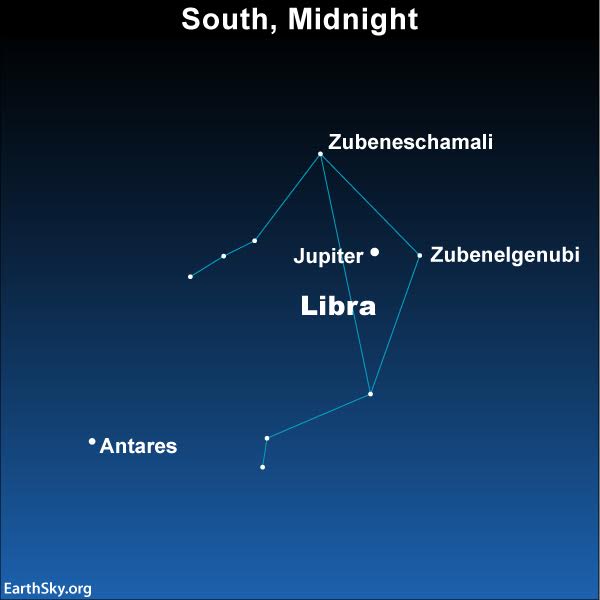
In 2018, the planet Jupiter acts as your guide “star” to the constellation Libra.
Jupiter shines in front of the constellation Libra the Scales until November 2018 (see sky chart above). Look for Libra’s brightest stars near Jupiter, Zubenelgenubi and Zubeneschamali (both star names are pronounced with the same rhythm as Obi-Wan Kenobi, of Star Wars). If you aim binoculars at Zubenelgenubi, you’ll see this star as two stars. Zubeneschamali, meanwhile, is said to appear green in color, although, astronomers say, stars can’t look green.
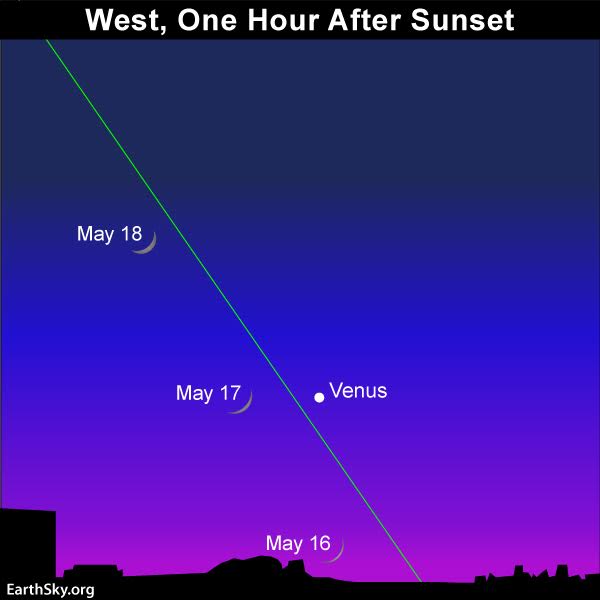
The young waxing crescent moon swings by the planet Venus on May 16, 17 and 18. Read more.
Venus is the brightest planet. Throughout May, Venus appears as a dazzling evening “star,” found in the west after sunset. This month, the planet is still climbing upward from the sunset point. Each evening in May, it stays out longer after the sun sets. Look for Venus to adorn the western evening sky until October 2018.
Circle May 17 on your calendar. That’s when the young moon swings close to Venus for a picturesque pairing in the western twilight (see the sky chart above).
At mid-northern latitudes (U.S., Europe, Japan), Venus sets about two hours after the sun at the beginning of May, and by the month’s end, sets about 2 1/2 hours after sunset. From temperate latitudes in the Southern Hemisphere (South Africa, southern Australia, New Zealand), Venus sets about 1 1/2 hours after the sun in early May, and by the month’s end, sets about 2 1/2 hours after sunset. Click here for recommended sky almanacs; they can give you Venus’ setting time in your sky.
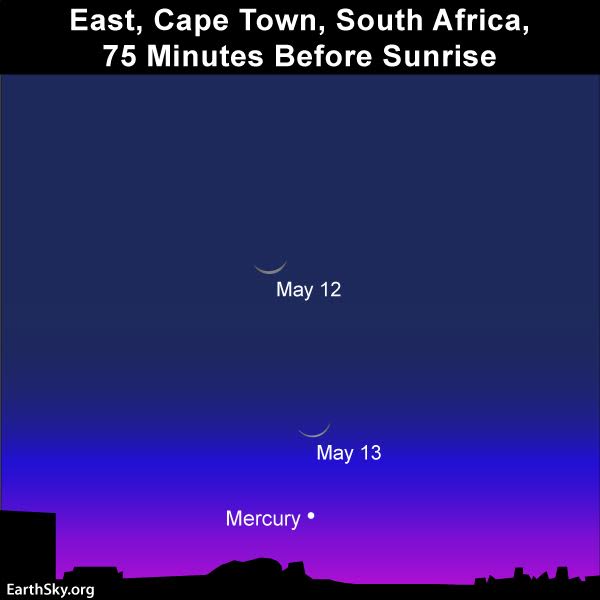
From southerly latitudes, the waning crescent moon helps to guide your eye to the planet Mercury on April 13 and 14. Read more.
Mercury, the innermost planet of the solar system, remains a fixture of the morning sky throughout May 2018, though the first half of the month offers better viewing. The present morning apparition of Mercury in April and May 2018 is the best of the year for the Southern Hemisphere, but poorest of the year for the Northern Hemisphere.
Mercury reached its greatest western elongation from the sun on April 29, 2018. At temperate latitudes in the Southern Hemisphere (South Africa, southern Australia, New Zealand), Mercury rises more than two hours before the sun during the first week of May. But at mid-northern latitudes (United States, Europe, Japan), Mercury struggles to climb over the horizon even as much as one hour before sunrise in early May.
What do we mean by bright planet? By bright planet, we mean any solar system planet that is easily visible without an optical aid and that has been watched by our ancestors since time immemorial. In their outward order from the sun, the five bright planets are Mercury, Venus, Mars, Jupiter and Saturn. These planets actually do appear bright in our sky. They are typically as bright as – or brighter than – the brightest stars. Plus, these relatively nearby worlds tend to shine with a steadier light than the distant, twinkling stars. You can spot them, and come to know them as faithful friends, if you try.
Bottom line: In May 2018, Venus appears in the west in evening twilight, Jupiter rises at early-to-mid evening and is low in the southwest by dawn. Mars and Saturn rise late at night but are well placed in the predawn/dawn sky. Mercury makes an appearance in the east before sunrise in the first half of April (at southerly latitudes). Click here for recommended almanacs; they can help you know when the planets rise, transit and set in your sky.
Don’t miss anything. Subscribe to EarthSky News by email
Enjoy knowing where to look in the night sky? Please donate to help EarthSky keep going.
Get your EarthSky 2018 lunar calendar now, while they last.
Visit EarthSk’s Best Places to Stargaze, and recommend a place we can all enjoy.
from EarthSky https://ift.tt/IJfHCr


The waxing gibbous moon travels away from the star Spica and toward the dazzling planet Jupiter on the nights of April 28, 29 and 30, 2018.

The moon couples up with Saturn in the morning sky on May 4 and Mars on May 6. Read more.
Follow the links below to learn more about the planets in May 2018:
Mars and Saturn, Jupiter, Venus, Mercury
Mars and Saturn rise into the southeast sky quite late at night throughout May (especially as viewed from the Northern Hemisphere). Your best view of them is in the predawn hours, when these planets appear much higher up in the sky. You can tell Mars from Saturn because Mars has a reddish color. Saturn looks golden. Binoculars show their colors better than the eye alone.
Mars and Saturn shine in front of Sagittarius, the constellation marking the direction to our galaxy’s center. Use the moon to locate Mars and Saturn on the mornings of May 4, 5 and 6. As the month progresses, Mars travels farther and farther east of Saturn on the sky’s dome, to move out of the constellation Sagittarius and into the constellation Capricornus by mid-May 2018. Saturn, in the meantime, stays in front of the constellation Sagittarius for a few more years.
At present, both Mars and Saturn shine as brilliantly as 1st-magnitude stars. However, Mars is brighter than Saturn. Saturn’s brilliance will increase until it peaks at its June 27 opposition, and Mars’ brilliance will also increase until it peaks at its July 27 opposition.
But Saturn’s brightness increase will be subtle, while Mars’ will be dramatic! It’s not often that Mars outshines Jupiter, normally the fourth-brightest celestial object to light up the sky. The three brightest celestial bodies are the sun, moon and Venus. But Mars will actually become the fourth-brightest for a couple of months in 2018, centered on Mars’ July 27 opposition. Remember Mars’ historically close opposition of August 28, 2003? That year, it was closer and brighter than it had been in some 60,000 years. This upcoming July opposition will be the best since then.
In early May, at mid-northern latitudes (U.S., Europe, Japan), Saturn rises about 11 p.m. local time (12 midnight local daylight-saving time) and Mars follows Saturn into the sky roughly an hour later. By the month’s end, Saturn comes up just after nightfall (about when Venus sets) whereas Mars doesn’t climb above the horizon until roughly 11 p.m. local time (12 midnight local daylight-saving time).
As for temperate latitudes in the Southern Hemisphere (South Africa, southern Australia, New Zealand), Saturn rises around 9 p.m. local time and Mars about an hour later, around 10 p.m. local time. By the end of the month, Saturn rises around 8 p.m (about when Venus sets) and Mars comes up about 10 p.m.local time.
Read more: Mars brighter in 2018 than since 2003
Click here for more about close and far Mars oppositions

Diagram by Roy L. Bishop. Copyright Royal Astronomical Society of Canada. Used with permission. Visit the RASC estore to purchase the Observers Handbook, a necessary tool for all skywatchers. Read more about this image.

The green line depicts the ecliptic – the pathway of the sun, moon and planets in front of the constellations of the zodiac. Let the moon guide your eye to the stars Spica and Antares, and the planet Jupiter, on May 25, 26, 27 and 28. Read more.
Jupiter enjoys its moment of glory as it reaches opposition on the night of May 8-9, 2018. In May 2018, Jupiter ranks as the fourth-brightest sky object, after the sun, moon and Venus. Look southeast at nightfall or early evening, and if you see a starlike object near the horizon that’s brighter than any star, that’s probably Jupiter. Late in the month, let the moon guide your eye to Jupiter on the evenings of May 25,26, 27 and 28.
In early May, at mid-northern latitudes (U.S., Europe, Japan), Jupiter comes up at roughly 10 p.m. (11 p.m. daylight saving time) local time. At temperate latitudes in the Southern Hemisphere (South Africa, southern Australia and New Zealand), Jupiter is up around 9 p.m. local time in early April. After Jupiter rises, it’s out for the rest of the night.
Around its opposition on on the night of May 8-9, 2018 – when Earth flies between Jupiter and the sun, gaining a lap on the planet for this year – Jupiter will be rising in the east as the sun sets in the west, to beam all night, from dusk until dawn.
It’ll be fun to watch Jupiter and Venus in May. Early in the month, at nightfall and early evening, look for Venus to blaze away in the west at the same time that Jupiter lights up the eastern sky. By the month’s end, you should easily see the sky’s two brightest planets – Venus in the west, and Jupiter in the east – at evening dusk.

In 2018, the planet Jupiter acts as your guide “star” to the constellation Libra.
Jupiter shines in front of the constellation Libra the Scales until November 2018 (see sky chart above). Look for Libra’s brightest stars near Jupiter, Zubenelgenubi and Zubeneschamali (both star names are pronounced with the same rhythm as Obi-Wan Kenobi, of Star Wars). If you aim binoculars at Zubenelgenubi, you’ll see this star as two stars. Zubeneschamali, meanwhile, is said to appear green in color, although, astronomers say, stars can’t look green.

The young waxing crescent moon swings by the planet Venus on May 16, 17 and 18. Read more.
Venus is the brightest planet. Throughout May, Venus appears as a dazzling evening “star,” found in the west after sunset. This month, the planet is still climbing upward from the sunset point. Each evening in May, it stays out longer after the sun sets. Look for Venus to adorn the western evening sky until October 2018.
Circle May 17 on your calendar. That’s when the young moon swings close to Venus for a picturesque pairing in the western twilight (see the sky chart above).
At mid-northern latitudes (U.S., Europe, Japan), Venus sets about two hours after the sun at the beginning of May, and by the month’s end, sets about 2 1/2 hours after sunset. From temperate latitudes in the Southern Hemisphere (South Africa, southern Australia, New Zealand), Venus sets about 1 1/2 hours after the sun in early May, and by the month’s end, sets about 2 1/2 hours after sunset. Click here for recommended sky almanacs; they can give you Venus’ setting time in your sky.

From southerly latitudes, the waning crescent moon helps to guide your eye to the planet Mercury on April 13 and 14. Read more.
Mercury, the innermost planet of the solar system, remains a fixture of the morning sky throughout May 2018, though the first half of the month offers better viewing. The present morning apparition of Mercury in April and May 2018 is the best of the year for the Southern Hemisphere, but poorest of the year for the Northern Hemisphere.
Mercury reached its greatest western elongation from the sun on April 29, 2018. At temperate latitudes in the Southern Hemisphere (South Africa, southern Australia, New Zealand), Mercury rises more than two hours before the sun during the first week of May. But at mid-northern latitudes (United States, Europe, Japan), Mercury struggles to climb over the horizon even as much as one hour before sunrise in early May.
What do we mean by bright planet? By bright planet, we mean any solar system planet that is easily visible without an optical aid and that has been watched by our ancestors since time immemorial. In their outward order from the sun, the five bright planets are Mercury, Venus, Mars, Jupiter and Saturn. These planets actually do appear bright in our sky. They are typically as bright as – or brighter than – the brightest stars. Plus, these relatively nearby worlds tend to shine with a steadier light than the distant, twinkling stars. You can spot them, and come to know them as faithful friends, if you try.
Bottom line: In May 2018, Venus appears in the west in evening twilight, Jupiter rises at early-to-mid evening and is low in the southwest by dawn. Mars and Saturn rise late at night but are well placed in the predawn/dawn sky. Mercury makes an appearance in the east before sunrise in the first half of April (at southerly latitudes). Click here for recommended almanacs; they can help you know when the planets rise, transit and set in your sky.
Don’t miss anything. Subscribe to EarthSky News by email
Enjoy knowing where to look in the night sky? Please donate to help EarthSky keep going.
Get your EarthSky 2018 lunar calendar now, while they last.
Visit EarthSk’s Best Places to Stargaze, and recommend a place we can all enjoy.
from EarthSky https://ift.tt/IJfHCr

Aucun commentaire:
Enregistrer un commentaire